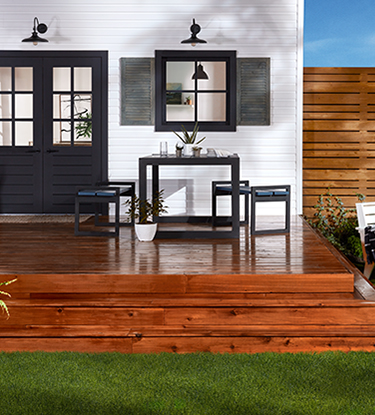Beautiful Deck Styles: The Influence of the Right Stain Option
Beautiful Deck Styles: The Influence of the Right Stain Option
Blog Article
A Comprehensive Overview to Various Kinds Of Deck Discoloration Techniques for Ultimate Defense and Aesthetic Appeals
In the world of deck maintenance, the art of tarnishing stands as a pivotal action towards both preserving the honesty of your outside space and enhancing its aesthetic charm. As we navigate via the complex world of deck discoloration methods, one begins to appreciate the nuanced techniques that can make all the difference in between an average finish and a perfect one.
Comprehending Different Sorts Of Stains
Numerous types of discolorations are frequently made use of in the process of deck discoloration to accomplish various aesthetic and safety impacts. Clear discolorations are optimal for showcasing the all-natural grain of the wood while giving very little defense against UV rays and dampness. On the other hand, semi-transparent discolorations provide an equilibrium in between color improvement and security, enabling some timber grain to reveal through. For an extra nontransparent finish that offers maximum defense against the components, strong discolorations are the favored choice. These discolorations come in a variety of shades and properly conceal the wood grain.
Toners include a hint of color to the wood while supplying very little protection, making them suitable for newer decks with much less wear. Recognizing the characteristics and advantages of each type of tarnish is important for achieving the desired appearance and resilience for your deck.
Picking the Right Stain Shade
When considering the visual appeals of your deck discoloration job, the selection of tarnish color plays a vital role in enhancing the safety qualities of the picked stain type (Water-Based Stains). The shade you pick can substantially impact the total appearance of your deck, in addition to its capacity to stand up to the elements over time
When selecting a discolor color, it's important to consider the existing color design of your home's outside. Balancing the deck discolor with the total aesthetic of your residential property can create a cohesive and visually enticing exterior room. Additionally, the color of your deck discolor can influence the temperature of the deck surface area; darker colors tend to soak up even more warmth, while lighter colors reflect sunshine and remain cooler.
In addition, the kind of wood you are staining will certainly also impact exactly how the discolor shade shows up. Various wood varieties can communicate with the stain in different ways, possibly altering the final color. It's advisable to test the stain on a tiny, unnoticeable area of the deck to guarantee the color ends up as preferred before waging the whole job.
Preparing Your Deck for Discoloration
To make certain a durable and successful deck staining task, detailed preparation of the deck surface area is important. Begin by cleaning up the deck thoroughly to remove dirt, grime, mildew, and any old complete or discolor.
Examine the deck for any kind of harmed or rotten boards that require to be replaced. Hammer down any type of sticking out nails and sand any harsh areas to make sure a smooth surface for discoloration. Look for any loose barriers site here or steps that may require tightening or fixing.
As soon as the deck is clean, completely dry, and in excellent repair work, think about applying a timber brightener to restore the deck's all-natural color and open up the timber pores for far better stain penetration. Ultimately, secure any neighboring plants, furniture, or surfaces with plastic sheeting before proceeding with the staining procedure. Proper preparation is key to attaining a professional-looking coating and making the most of the long life of your deck stain.
Applying Stain With Numerous Techniques
For a professional and remarkable coating, the technique of using discolor plays a vital function in enhancing the appearance and longevity of your deck. There are a number of strategies you can use to make sure an efficient application of stain.
It is ideal for elaborate locations and getting to in between deck boards. Back-brushing after rolling is check over here suggested to even out the tarnish and function it right into the wood for much better infiltration.
Spraying is another prominent technique, using rate and convenience of application, specifically for large deck areas. Whichever technique you select, guaranteeing appropriate preparation and adhering to manufacturer guidelines will certainly assist achieve a resilient and attractive tarnish finish on your deck.

Keeping and Re-staining Your Deck
When it comes to re-staining your deck, the frequency depends on different variables such as the kind of tarnish used, the climate in your area, and just how much wear and tear your deck experiences. Typically, it is advised to re-stain your deck every 2-4 years to preserve its security and aesthetics.
Before re-staining, make sure the deck is clean, dry, and free of any previous discolor deposit. Choose a top notch tarnish that matches your deck's product and gives the wanted level of security.
Verdict
Finally, understanding the various kinds of deck discolorations, picking the ideal shade, correctly preparing the deck, applying tarnish with various methods, and preserving and re-staining the deck are essential actions for utmost security and visual appeals. By adhering to these steps, you check this site out can make sure that your deck remains in top condition for many years to come.
Additionally, the shade of your deck discolor can affect the temperature of the deck surface area; darker shades have a tendency to soak up more warm, while lighter colors show sunshine and stay cooler.
It's suggested to evaluate the tarnish on a small, low-profile location of the deck to guarantee the shade turns out as wanted before proceeding with the whole project.

Report this page